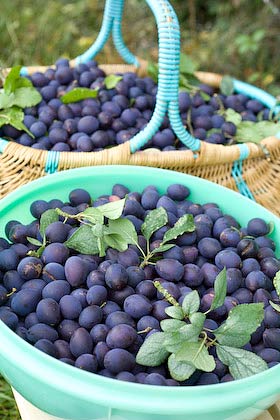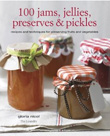
On many afternoons recently, I’ve taken an hour or so out, to go for a walk foraging for ingredients. Some days this gives me a headache, as foraging can be a very intense activity and the level of ‘looking’ becomes a bit over the top. It is a brilliant way of discovering things though, when you look that hard you see things you would otherwise miss and find things you didn’t know where there. Foraging is not without its dangers however. I am forever getting my hair tangled in trees, ripping my legs through brambles and wacking my head on low branches when intently focused on something just out of arms reach. It is just too tantalising to go away from the path when you think there might be something to be found ‘off piste’. The other day I came across some windfall wild crab apples that required that I crouch down and crawl on all fours under low lying branches to gather them up to take home. Going forward wasn’t such a problem but backing out with my basket full and a camera round my neck wasn’t quite so easy.
A couple of weeks earlier I’d been to harvest wild damsons, from a place in the forest I’d found the year before so I already had plenty of damsons at home waiting for the jam kettle. One by one, as you clock another crop, you are able to add them to your own personal ordinance survey map of fruits and berries.

I love damsons anyway and the idea of mixing them with the crab apples, both wild fruits together, harvested on my doorstep, seemed a perfect pairing. Damsons can be quite a pain to stone and wild damsons being smaller means there’s even more stones to contend with. Making a fruit cheese is the perfect solution, as both fruits can be cooked with very little in the way of preparation and then be forced through a food mill to leave just the fruit puree and dispense with peel and pips, cores and stones. Though it does require considerable patience I like using a food mill, but last year I found a vintage attachment for my Kenwood Chef on eBay that does the same thing, so now I’m all automated.
Membrillo, made from quince, is probably the most popular fruit cheese, served with the cheese board at the end of a meal, but damsons and crab apples have a particularly appealing Englishness about them. Fruit cheeses are cooked down until they are really thick and will set solid as they cool. This means they can be turned out and served in slices as opposed to dolloped from a spoon. They need to be contained in jars or pots with slightly sloping sides that are wider at the top so they turn out easily. There are small glass jam jars around made for this purpose but I’m really lucky that Martin, in the pottery at Taurus Crafts made me some special hand-thrown stoneware jam pots, inspired by some vintage French ones I own. It is advised that in order to make it easy to turn out the cheese, you lightly oil the ‘moulds’ using ground nut oil or some glycerine if you just happen to have some handy.

CRAB APPLE AND WILD DAMSON CHEESE
Rinse and drain the crab apples. Chop them roughly and place in a pan. Add enough water to just cover the fruit, bring to the boil and simmer gently for 20-30 minutes, till cooked through. Remove from the heat, leave to cool then push through a fine seive or food mill over a bowl to remove the skins, cores and pips and leave a smooth puree.
Rinse and drain the damsons, place in a pan and add just enough water to barely cover the fruit. Bring to the boil and simmer for 30 minutes, till cooked through and the fruit has burst. Remove from the heat, leave to cool, then push through a sieve or process with a food mill to remove the skins and stones and leave a smooth damson puree.
I combined 800g (1.75lbs) damson puree with 400g (14oz) apple puree, so two thirds damsons to one third apple, but you can change the ratio to suit yourself and the quantities you have available. To every 600g (1.3lbs) fruit add 450g (1lb) sugar. Place the fruit and sugar in a pan and stir over a low heat until the sugar is completely dissolved. Turn up the heat and bring to the boil then simmer, stirring from time to time to be sure it doesn’t catch and burn on the bottom of the pan. Continue to cook until the mixture thickens considerably and when you pull the spoon across the centre it draws a line. This may take and hour or even longer to achieve and it is best to be patient and keep the heat really low under the pan. Pour the mixture into hot sterilised jars that are lightly oiled, cover with greaseproof waxed circles and seal. Leave till set and cold.

oh my! everything in this post looks scrumptious! i want that cheese – please send. ;). seriously I have not tried making fruit cheese yet but so want to!
Comment by tigress 10.15.10 @ 4:47 amMmmmn! Sounds delicious. I love damson cheese and haven’t tried it mixed with crab apple so must give it a go. Those little pots are so beautiful too.
Jane
Comment by Jane 10.15.10 @ 8:00 amThat sounds delicious,I’ll be out of the door looking for crab apples in 5 minutes!
Last week we opened a jar of spiced blackberry and apple cheese from 2008 – still absolutely gorgeous.
That cheese looks & sounds wonderful! I’ve made plain old apple cheese in the past, and I know that there are meant to be damsons growing around my area (I’ve not found any evidence of it though!). Your recipes and photos are always such an inspiration!
Comment by H is for Home 10.15.10 @ 11:33 amI was just reading a recipe this morning for exactly for this. The other day I made membrillo, god I love it. But now I have tons of crabapples and plums. Only problem: I don’t have damsons. I was just going to use what I have. Also, I was going to do it in a baking tray, instead of little cups, so I can slice slabs. What do you think?
Comment by Julia 10.16.10 @ 6:18 pmI think you can make a perfectly lovely fruit cheese with plums instead of damsons. It wont have quite the same distinctive flavour but your crab apples will be tart and characterful and the cooking time concentrates the flavours as well. The baking tray should be fine too. It is a short hop from a fruit butter to pate de fruit to a fruit leather. They are all variations on a theme really. Should be lovely.
Comment by laundryetc 10.16.10 @ 8:03 pmOh my goodness, Gloria, this looks just lovely in every way. I love those little crocks! I did just get some more quince so I may try membrillo, but if I ever find myself with damsons and crabapples I will surely remember this post.
Comment by Shae 10.18.10 @ 7:17 amwhere is the cheese recipe?
Comment by Debbie 10.18.10 @ 2:31 pmHi Gloria, looks like you’ve been busy over the past few days! Wish I’d read your cheese recipe before I tried to make some membrillo on Saturday…it has a bit of a setting issue (i.e. it’s not!), so think I’ll be scraping it out of the dishes and back into the pan to re-boil it for a bit. Keep your fingers crossed!
Comment by jillicious! 10.18.10 @ 9:18 pmI have on my list to do pear cheese and apple cheese. My gran use to make quince cheese which is the norm in Portugal this time of year but forget it about asking her for a recipe ’cause all you get is a bit of this and a bit of that!! no measurements no timings 🙂
What gorgeous colour you have on that!
Comment by azélias kitchen 11.05.10 @ 12:15 pmThank you for such a beautiful post! I have been so inspired by it :).
I was just wondering where you got your gorgeous the little pots from – are they enamel? I am making my annual raspberry and cumquat marmalade for the lovely elderly people I look after at a retirement village and I think these would be the perfect for them!
Comment by Jo 12.05.10 @ 4:59 pm[…] or “cheese.” Do you know another?) I am still beautifully haunted by the Crab Apple and Wild Damson Cheese posted by Gloria at Laundry, Etc. last fall. If you visit her blog, you can peek under the […]
Pingback by Clementine Pâté de Oops « Hitchhiking to Heaven 04.07.11 @ 10:20 pmDo you know whether I can make grape cheese?
Comment by Victoria Gibson 09.10.13 @ 11:30 am




